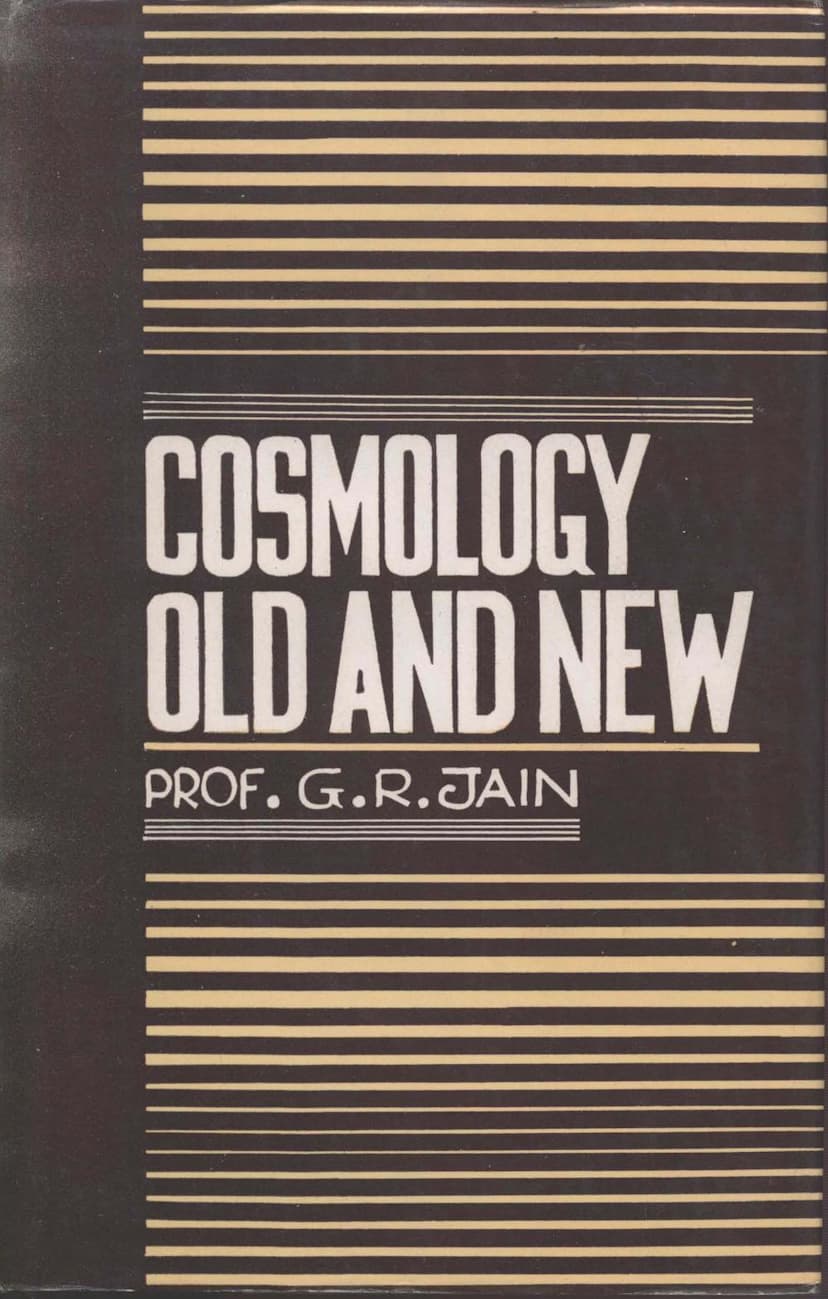Cosmology Old And New
Added to library: September 1, 2025

Summary
Based on the provided text, here's a comprehensive summary of "Cosmology Old and New" by Prof. G. R. Jain:
Book Overview:
"Cosmology: Old and New" by Prof. G. R. Jain is a modern commentary on the fifth chapter of the Tattvärtha-sutra of Acarya Umāsvāti, a foundational text in Jainism that deals with Jain cosmology. The book's primary aim is to compare and contrast the ancient Jain cosmological concepts with those presented in modern science. Prof. G. R. Jain, an eminent Professor of Physics and a prolific author, brings his expertise to this comparative study, making the work valuable for both students of Jainism and those interested in understanding Jainism through the lens of contemporary scientific understanding. This summary focuses on the key themes and arguments presented in the initial pages provided.
Core Objective:
The central purpose of the book is to bridge the gap between ancient Jain scientific thought and modern scientific discoveries, particularly in the realm of cosmology. Prof. Jain seeks to demonstrate the intellectual depth and surprising prescience of ancient Jain thinkers by examining their cosmological ideas in light of current scientific theories.
Key Aspects and Themes:
- Commentary on Tattvärtha-sutra, Chapter 5: The book systematically unpacks the concepts presented in the fifth chapter of the Tattvärtha-sutra, which is dedicated to the inanimate world and ontology, with a particular focus on cosmological elements.
- Modern Scientific Comparison: A significant portion of the book is dedicated to drawing parallels and contrasts between Jain cosmological principles and findings from modern physics, astronomy, and other scientific disciplines. This comparative approach is central to the book's contribution.
- Relevance of Jain Concepts: The author highlights how certain Jain concepts, such as the nature of matter (pudgala), space (ākāśa), time (kāla), and the principles of motion (dharma) and rest (adharma), resonate with or anticipate modern scientific understandings.
- Emphasis on Rationality and Observation: The book underscores the Jain emphasis on observation, logical reasoning, and the investigation of reality, aligning these with the spirit of modern scientific inquiry. Prof. Jain posits that ancient Indian science, including Jain thought, was not "asleep" during the millennia preceding modern scientific introductions.
- Historical Context of Jain Thought: The author attempts to place Jain scientific contributions within a historical context, suggesting that discoveries attributed to later Greek philosophers or even contemporary scientists might have had earlier roots in Jain literature. The challenge of tracing ancient knowledge due to the oral tradition is also mentioned.
- Critique of Oversimplification and Dogmatism: Prof. Jain cautions against forcing analogies or distorting religious principles to fit scientific theories. He advocates for an open-minded comparison, acknowledging where ancient and modern views agree and where they differ, and suggesting that science itself is an evolving process of approximations rather than absolute truths.
- Specific Jain Principles Discussed: The initial pages provide glimpses into the detailed discussion of various Jain cosmological principles. These include:
- The Six Realities (Dravyas): Jiva (Soul), Pudgala (Matter/Energy), Akasa (Space), Kala (Time), Dharma (Medium of Motion), and Adharma (Medium of Rest).
- Nature of Pudgala: Its classification, the meaning of the word "pudgala" as "that which undergoes modification by combination and dissociation," and its relation to modern concepts of matter and energy.
- Dharma and Adharma: These non-material principles, analogous to modern concepts like Aether and Fields of force, are discussed in detail, highlighting their role in motion, rest, and the overall stability of the universe. The challenges faced by scientists in defining and detecting Aether are explored.
- Akasa (Space): Its dual nature as finite lokakasa (universe) and infinite alokakasa (pure space beyond), and its role as the accommodator of all other realities. Comparisons are drawn with modern mathematical concepts of finite but unbounded space.
- Kala (Time): Its division into apparent and absolute time, its pervasiveness within the universe, and its infinite and eternal nature.
- Pradeśa (Space-point): The fundamental unit of space, its definition, and the Jain concept of its accommodating power, which allows for the "packing" of numerous particles.
- Paramāņu: The ultimate, indivisible particle of matter, its comparison to modern elementary particles like electrons and positrons.
- Skandha: Aggregates of paramāņus, analogous to modern molecules and atoms.
- Śrutajñāna and Kevalajñāna: While not explicitly detailed in the provided pages, the context suggests an exploration of Jain epistemology and the nature of knowledge, particularly in relation to the "all-knowing" (Sarvajña Deva) concept.
- Syadvada and Anekantavada: The book emphasizes the Jain philosophical approach of multiple standpoints and conditional predication, comparing it to the relativity of scientific observations and the challenges of absolute pronouncements in physics.
Author's Approach:
Prof. G. R. Jain's approach is characterized by a deep respect for ancient Jain traditions and a rigorous application of scientific reasoning. He aims to validate Jain philosophical insights through scientific evidence and to highlight the advanced nature of Jain thought by comparing it with the latest scientific understandings. His work is presented as an "humble attempt" to bring the contributions of Jain thinkers in cosmology and atomic physics to the notice of the English-knowing public.
Significance:
The book serves as a bridge between classical Jain wisdom and contemporary scientific knowledge, offering a unique perspective on the universe and its fundamental principles from both an ancient philosophical and a modern scientific viewpoint. It aims to foster a greater appreciation for the Jain tradition's intellectual heritage and its relevance to understanding the cosmos today.